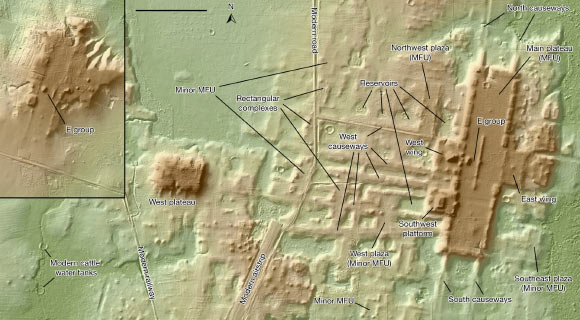An international team of archaeologists has discovered an artificial structure — which is 1,400 m in length, 10-15 m in height, has 9 causeways radiating out from it, and is about 3,000 years old — at the archaeological site of Aguada Fénix in Tabasco, Mexico, near the northwestern border of Guatemala. This is the oldest monumental construction ever found in the Maya area and the largest in the entire pre-Hispanic history of the region.
Source: Sci News
“Using low-resolution lidar collected by the Mexican government, we noticed this huge platform,” said Professor Takeshi Inomata, a researcher in the School of Anthropology at the University of Arizona.
“Then we did high-resolution lidar and confirmed the presence of a big building.”
“This area is developed — it’s not the jungle; people live there — but this site was not known because it is so flat and huge. It just looks like a natural landscape. But with lidar, it pops up as a very well-planned shape.”
The archaeologists then excavated the site and radiocarbon-dated 69 samples of charcoal to determine that the monument was constructed sometime between 1,000 to 800 BCE.
Until now, the Maya site of Ceibal, built in 950 BCE, was the oldest confirmed ceremonial center.
This oldest monumental building at Aguada Fénix turned out to be the largest known in the entire Maya history, far exceeding pyramids and palaces of later periods.
“The discovery marks a time of major change in Mesoamerica and has several implications,” Professor Inomata said.
First, archaeologists traditionally thought Maya civilization developed gradually.
Until now, it was thought that small Maya villages began to appear between 1000 and 350 BCE, what’s known as the Middle Preclassic period, along with the use of pottery and some maize cultivation.
Second, the site looks similar to the older Olmec civilization center of San Lorenzo to the west in the Mexican state of Veracruz, but the lack of stone sculptures related to rulers and elites, such as colossal heads and thrones, suggests less social inequality than San Lorenzo and highlights the importance of communal work in the earliest days of the Maya.
An aerial view of Aguada Fenix Main Plateau and the ramps connecting to causeways viewed from northwest. Image credit: Takeshi Inomata.
“There has always been debate over whether Olmec civilization led to the development of the Maya civilization or if the Maya developed independently,” Professor Inomata said.
“So, our study focuses on a key area between the two.”
The period in which the Aguada Fénix monument was constructed marked a gap in power — after the decline of San Lorenzo and before the rise of another Olmec center, La Venta.
“During this time, there was an exchange of new ideas, such as construction and architectural styles, among various regions of southern Mesoamerica,” Professor Inomata said.
“The extensive plateau and the large causeways suggest the monument was built for use by many people.”
“During later periods, there were powerful rulers and administrative systems in which the people were ordered to do the work. But this site is much earlier, and we don’t see the evidence of the presence of powerful elites. We think that it’s more the result of communal work.”
“The fact that monumental buildings existed earlier than thought and when Maya society had less social inequality makes archaeologists rethink the construction process.”
“It’s not just hierarchical social organization with the elite that makes monuments like this possible,” Professor Inomata said.
“This kind of understanding gives us important implications about human capability, and the potential of human groups. You may not necessarily need a well-organized government to carry out these kinds of huge projects. People can work together to achieve amazing results.”
The discovery is described in a paper in the journal Nature.
Source: Sci News

































Leave a Comment
You must be logged in to post a comment.